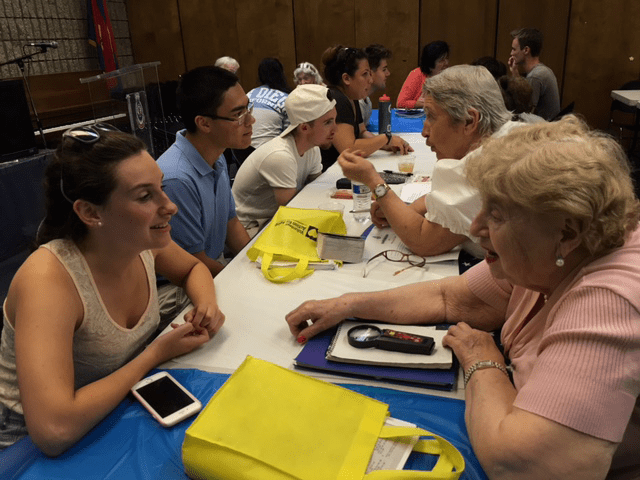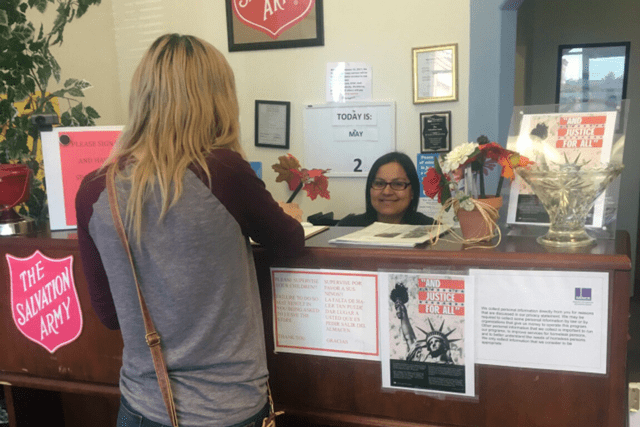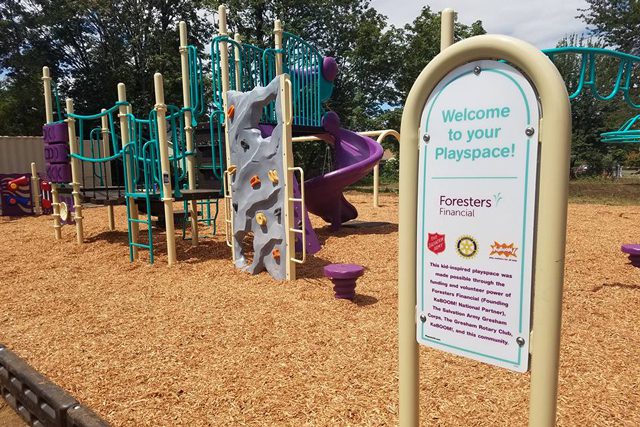Listen to this article
Listen to this article
Loading
Play
Pause
Options
0:00
-:--
1x
Playback Speed- 0.5
- 0.6
- 0.7
- 0.8
- 0.9
- 1
- 1.1
- 1.2
- 1.3
- 1.5
- 2
Audio Language
- English
- French
- German
- Italian
- Spanish
Open text
open doors at west women’s and children’s center. the shelter’s planned expansion could nearly triple its capacity. for nearly four decades, west women’s and children’s center near portland, oregon, has provided a safe haven and recovery system for thousands of victims of domestic violence. the shelter’s work won it the salvation army social services award for program excellence and achievement in 2017. its secret? building a community founded on personal connections. housing coordinator leaanne eivers said she felt a different connection working with the women than she has with other patients in previous jobs, even though she herself has never been a victim of domestic violence. many women, she said, experience similar feelings even if they haven’t experienced the same level of trauma. “i feel like because we are women, there’s an empathy and connection to those feelings of insecurity, or maybe not having the self-esteem and awareness,” eivers said. “because of those connections, you can also relate to that person and find the strength and hopefully guide them.”. that might be an innate quality that women share with each other, eivers said. but she’s seen it blossom at the shelter. the shelter has a long history of serving survivors with co-occurring issues, such as chemical dependency or disability, said director fay schuler. it’s also recognized for its work with native americans, a vastly underserved population. typically, 30 percent of the shelter’s survivors at any given time are native american, which is outstanding when considering only one percent of portland’s population is native american. the west is also known for its work with reunifying survivors of domestic violence with their children. the effect it has on the women is huge, schuler said. the impact of being without one’s children can be devastating to these women who are already going through so much. “it really kind of takes their hope away,” schuler said. “for some people, it really doesn’t give them the long-term goal or visioning of doing anything different.”. typically, they see about 10 reunifications a year, schuler said. the need for services the shelter provides is great, schuler said. many people outside of the area don’t realize there is a housing crisis in portland. the scarcity of safe, affordable housing only exacerbates the issues victims of domestic violence face. it’s difficult to find a rental property for under $1,500 a month, schuler said. plus there’s the costs associated with moving, such as down payments. and many shelters are at capacity, leaving limited options for women trying to escape abuse. “a survivor has to chose, ‘ok, i’m being abused and i’m scared for my life, but when i leave, there’s most likely not going to be a shelter available,’” schuler said. “over and over, survivors are choosing to stay in these very violent relationships because they feel they have no options.”. and there’s a disparity in the ratio of programs for homeless men versus women, eivers said. there’s a prevalent belief that men are more dangerous, and thus it’s of greater societal value to get them off the streets so others aren’t threatened. as a result, women, especially those without children, are somewhat forgotten, eivers said. “the single women, i find, are kind of an invisible entity in our town,” eivers said. “they’re not causing the crime, they’re usually the victims of it. and they kind of get left behind and there aren’t a lot of resources for them.”. while there are many other shelters in the portland area, eivers said there’s simply a different vibe when the salvation army is involved. “i’ve always said the salvation army uses its money and resources for the people,” eivers said. “we’re not pretentious whatsoever. we’re not fancy. and we aren’t particular about the kind of people that come into our shelter…we realize whoever is here is here for a reason.”. many shelters in the area have moved away from the basic needs of shelter and safety and more into wrap-around services to improve a person’s quality needs. those are all commendable things, eivers said, but the west believes shelter and safety must be addressed first before all other other aspects of one’s life can be improved. the salvation army supports that mission, eivers said, and helps to house and keep safe as many people as possible. in fact, the shelter is going through a major renovation that will expand it from 24 emergency beds to 60, nearly tripling its capacity. “we’re scrapers here at the west,” eivers said. “there’s nothing we won’t do. whatever it takes.”. for many emergency shelters, there’s a limit to what they provide—a basic 60-day turnaround to get things in order and leave the shelter. schuler acknowledges that not everyone is ready in 60 days. for those people, there are possible extensions. and for those who do leave, they might not be ready to give up all the services. that’s ok, too. almost every day, schuler sees women come back to eat lunch, visit the clothing closet or attend a counseling group. just the other day, schuler saw five women stop back in to visit and take part in some of the services. one came for food, another went to a counseling group, and another came to braid a resident’s hair. “it’s always different reasons, but they know they’re always welcome here,” schuler said. “they’ll always have those connections and that support.”.
Open context player
Close context player
Plays:-Audio plays count
open doors at west women’s and children’s center. the shelter’s planned expansion could nearly triple its capacity. for nearly four decades, west women’s and children’s center near portland, oregon, has provided a safe haven and recovery system for thousands of victims of domestic violence. the shelter’s work won it the salvation army social services award for program excellence and achievement in 2017. its secret? building a community founded on personal connections. housing coordinator leaanne eivers said she felt a different connection working with the women than she has with other patients in previous jobs, even though she herself has never been a victim of domestic violence. many women, she said, experience similar feelings even if they haven’t experienced the same level of trauma. “i feel like because we are women, there’s an empathy and connection to those feelings of insecurity, or maybe not having the self-esteem and awareness,” eivers said. “because of those connections, you can also relate to that person and find the strength and hopefully guide them.”. that might be an innate quality that women share with each other, eivers said. but she’s seen it blossom at the shelter. the shelter has a long history of serving survivors with co-occurring issues, such as chemical dependency or disability, said director fay schuler. it’s also recognized for its work with native americans, a vastly underserved population. typically, 30 percent of the shelter’s survivors at any given time are native american, which is outstanding when considering only one percent of portland’s population is native american. the west is also known for its work with reunifying survivors of domestic violence with their children. the effect it has on the women is huge, schuler said. the impact of being without one’s children can be devastating to these women who are already going through so much. “it really kind of takes their hope away,” schuler said. “for some people, it really doesn’t give them the long-term goal or visioning of doing anything different.”. typically, they see about 10 reunifications a year, schuler said. the need for services the shelter provides is great, schuler said. many people outside of the area don’t realize there is a housing crisis in portland. the scarcity of safe, affordable housing only exacerbates the issues victims of domestic violence face. it’s difficult to find a rental property for under $1,500 a month, schuler said. plus there’s the costs associated with moving, such as down payments. and many shelters are at capacity, leaving limited options for women trying to escape abuse. “a survivor has to chose, ‘ok, i’m being abused and i’m scared for my life, but when i leave, there’s most likely not going to be a shelter available,’” schuler said. “over and over, survivors are choosing to stay in these very violent relationships because they feel they have no options.”. and there’s a disparity in the ratio of programs for homeless men versus women, eivers said. there’s a prevalent belief that men are more dangerous, and thus it’s of greater societal value to get them off the streets so others aren’t threatened. as a result, women, especially those without children, are somewhat forgotten, eivers said. “the single women, i find, are kind of an invisible entity in our town,” eivers said. “they’re not causing the crime, they’re usually the victims of it. and they kind of get left behind and there aren’t a lot of resources for them.”. while there are many other shelters in the portland area, eivers said there’s simply a different vibe when the salvation army is involved. “i’ve always said the salvation army uses its money and resources for the people,” eivers said. “we’re not pretentious whatsoever. we’re not fancy. and we aren’t particular about the kind of people that come into our shelter…we realize whoever is here is here for a reason.”. many shelters in the area have moved away from the basic needs of shelter and safety and more into wrap-around services to improve a person’s quality needs. those are all commendable things, eivers said, but the west believes shelter and safety must be addressed first before all other other aspects of one’s life can be improved. the salvation army supports that mission, eivers said, and helps to house and keep safe as many people as possible. in fact, the shelter is going through a major renovation that will expand it from 24 emergency beds to 60, nearly tripling its capacity. “we’re scrapers here at the west,” eivers said. “there’s nothing we won’t do. whatever it takes.”. for many emergency shelters, there’s a limit to what they provide—a basic 60-day turnaround to get things in order and leave the shelter. schuler acknowledges that not everyone is ready in 60 days. for those people, there are possible extensions. and for those who do leave, they might not be ready to give up all the services. that’s ok, too. almost every day, schuler sees women come back to eat lunch, visit the clothing closet or attend a counseling group. just the other day, schuler saw five women stop back in to visit and take part in some of the services. one came for food, another went to a counseling group, and another came to braid a resident’s hair. “it’s always different reasons, but they know they’re always welcome here,” schuler said. “they’ll always have those connections and that support.”.
Listen to this article














